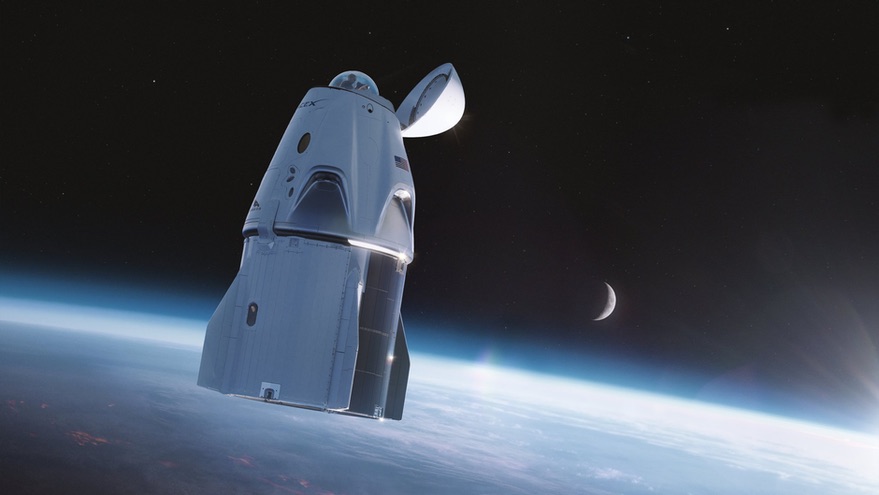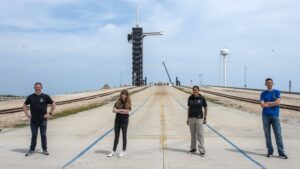Isaacman announced the mission Feb. 1, starting a pair of contests to select two people who would fly with him.
One of those people is Sian Proctor, a scientist and educator who has participated in a number of terrestrial “analog astronaut” missions. She won the seat called “Prosperity” by establishing an online store through Isaacman’s company, Shift4 Payments, and submitting a video judged by an independent panel.
The second is Chris Sembroski, a Lockheed Martin employee in the Seattle area. He won the “Generosity” seat by participating in a sweepstakes that raised money for St. Jude Children’s Research Hospital.
The fourth member of the crew, previously announced, is Hayley Arceneaux, a physician assistant at St. Jude who, as a child, was treated for bone cancer there. At 29, Arceneaux would be the youngest American in space.
“We promised a crew representing some of the best of humanitarian qualities, exemplifying our mission ideals of leadership, hope, prosperity and generosity,” Isaacman said. “I’m pleased to report that we’ve accomplished that goal.”
The four will start training as a group immediately, he said. That training includes time in Crew Dragon simulators, going through all aspects of the mission, as well as centrifuges to simulate the accelerations of launch and reentry and “other forms of stress testing.”
In addition to announcing the crew, Isaacman and SpaceX outlined the details of the mission itself. Launch is scheduled for no earlier than Sept. 15, slightly earlier than the original announcement of the fourth quarter of this year. The spacecraft will remain in orbit for three days, flying in an orbit at the same inclination as the International Space Station — 51.6 degrees — but in an orbit as high as 540 kilometers, more than 100 kilometers above the station.
That particular orbit, Isaacman said, will be the highest people have been above the Earth’s surface since the final shuttle servicing mission to the Hubble Space Telescope in 2009. “It should send a message,” he said, one of going beyond the ISS. “We’re ready to go back to the moon, and we’re ready to go beyond the moon to Mars. Extending out a little bit farther than where we’ve been for some time right now is a good step in the right direction.”
The three-day mission duration, he added, “is a good balance between the capabilities of the Dragon spacecraft and how much time you want to spend in a relatively small space for a couple days together.”
Benji Reed, senior director of human spaceflight programs at SpaceX, said the company moved up the mission slightly to September to accommodate the Crew-3 launch for NASA later in the fall. “This crew, with training, we believe will be ready by September, as well as the Dragon,” he said. “It works out very well with our manifest.”
The Inspiration4 mission will use the same Dragon spacecraft, called Resilience, currently docked at the ISS for the Crew-1 mission. That spacecraft is currently scheduled to return to Earth April 28, assuming the Crew-2 mission launches to the station on schedule April 22. “We feel very good about the timeframe we’re working in” to refurbish the spacecraft for Inspiration4.

Besides refurbishing the spacecraft, SpaceX will install an additional window on the spacecraft, a viewing port modeled on the space station’s cupola that will replace the docking adapter under the spacecraft’s nose cone. Since the Inspiration4 mission will not dock with the station, that adapter is not needed.
“It’s awesome,” Reed said of the cupola. Qualification and testing of the cupola is in progress, and Reed said SpaceX will ensure that its installation doesn’t preclude using the spacecraft for later missions, such as those to the station that will require the reinstallation of the docking adapter.
Inspiration4 will be the first Crew Dragon mission for a customer other than NASA, but it is not the only one on its manifest. Axiom Space will fly four people to the ISS on its Ax-1 mission in early 2022. Space Adventures previously announced a Crew Dragon mission that would fly well above the station, but that space tourism company has not provided any updates on its schedule for that mission.
“We’re trying to deliver an awful lot of messages with this mission,” Isaacman said. “When this mission is complete, people are going to look at it and say this was the first time that everyday people could go to space.”
However, Inspiration4 may have overestimated the interest in the mission. Proctor was one of only about 200 people who participated in the Prosperity competition, which required no expense beyond the time setting up an online store and producing a video. Sembroski was selected from nearly 72,000 entries, which could be purchased at the rate of 10 entries per dollar, up to 10,000 entries per person.
That limited interest has hurt Inspiration4’s efforts to raise money for St. Jude. The mission has raised a little less than $13 million for the hospital as of March 30, most of which was raised when the sweepstakes was open in February. That’s well short of the goal of $100 million set when Inspiration4 was announced Feb. 1.
“We’ve helped drive a significant amount of donations to St. Jude Children’s Research Hospital,” Isaacman said. “This fundraising effort is really far from over. We’ll be continuing throughout the year.” He didn’t elaborate on those future fundraising plans.



